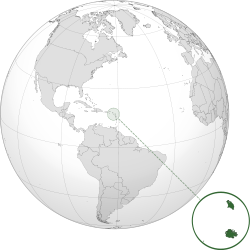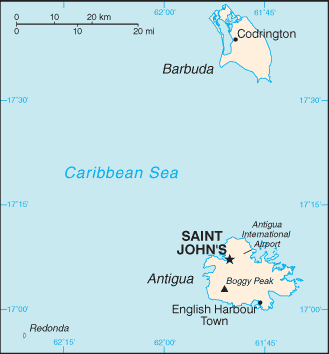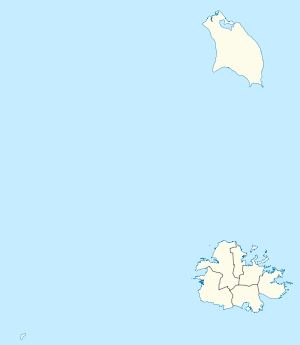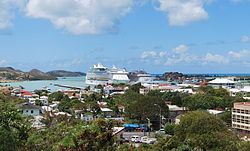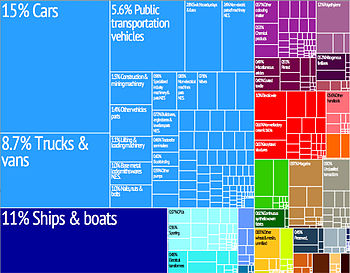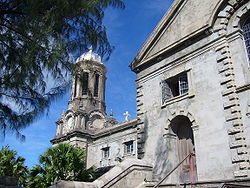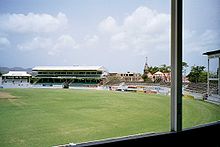
Antigua and Barbuda
Background to the schools Wikipedia
SOS Children volunteers helped choose articles and made other curriculum material Do you want to know about sponsoring? See www.sponsorachild.org.uk
| Antigua and Barbuda | ||||||
|---|---|---|---|---|---|---|
|
||||||
| Motto: "Each Endeavouring, All Achieving" | ||||||
| Anthem: Fair Antigua, We Salute Thee Royal anthem: God Save the Queen a |
||||||
|
|
||||||
| Capital and largest city |
Saint John's 17°7′N 61°51′W |
|||||
| Official languages | English | |||||
| Local language | Antiguan Creole | |||||
| Ethnic groups (1996) |
|
|||||
| Demonym |
|
|||||
| Government | Parliamentary democracy under unitary constitutional monarchy |
|||||
| - | Monarch | Elizabeth II | ||||
| - | Governor-General | Dame Louise Lake-Tack | ||||
| - | Prime Minister | Baldwin Spencer | ||||
| - | Opposition Leader | Gaston Browne formerly Lester Bird | ||||
| Legislature | Parliament | |||||
| - | Upper house | Senate | ||||
| - | Lower house | House of Representatives | ||||
| Independence | ||||||
| - | from the United Kingdom | 1 November 1981 | ||||
| Area | ||||||
| - | Total | 440 km2 ( 195th) 170 sq mi |
||||
| - | Water (%) | negligible | ||||
| Population | ||||||
| - | 2011 census | 81,799 | ||||
| - | Density | 186/km2 481/sq mi |
||||
| GDP ( PPP) | 2012 estimate | |||||
| - | Total | $1.579 billion | ||||
| - | Per capita | $18,026 | ||||
| GDP (nominal) | 2012 estimate | |||||
| - | Total | $1.176 billion | ||||
| - | Per capita | $13,428 | ||||
| HDI (2011) | high · 60th |
|||||
| Currency | East Caribbean dollar ( XCD) |
|||||
| Time zone | AST ( UTC-4) | |||||
| Drives on the | left | |||||
| Calling code | +1-268 | |||||
| ISO 3166 code | AG | |||||
| Internet TLD | .ag | |||||
| a. | God Save The Queen is the official national anthem, but is generally used only on regal and vice-regal occasions. | |||||
Antigua and Barbuda ( / æ n ˈ t iː ɡ ə æ n d b ɑr ˈ b juː d ə /; Spanish for "ancient" and "bearded") is a twin- island nation lying between the Caribbean Sea and the Atlantic Ocean. It consists of two major inhabited islands, Antigua and Barbuda, and a number of smaller islands (including Great Bird, Green, Guinea, Long, Maiden and York Islands and further south, the island of Redonda). The permanent population numbers approximately 81,800 (at the 2011 Census) and the capital and largest port and city is St. John's, on Antigua.
Separated by a few nautical miles, Antigua and Barbuda are in the middle of the Leeward Islands, part of the Lesser Antilles, roughly at 17 degrees north of the Equator. The country is nicknamed "Land of 365 Beaches" due to the many beaches surrounding the islands. Its governance, language, and culture have all been strongly influenced by the British Empire, of which the country was formerly a part.
History
Antigua was first settled by Archaic Age hunter-gatherer Amerindians, erroneously referred to as Siboney or Ciboney. Carbon-dating has established that the earliest settlements started around 3100 BC. They were succeeded by the Ceramic Age pre-Columbian Arawak-speaking Saladoid people who migrated from the lower Orinoco River.
The Arawaks introduced agriculture, raising, among other crops, the famous Antigua Black Pineapple (Moris cultivar of Ananas comosus), corn, sweet potatoes (white with firmer flesh than the bright orange "sweet potato" used in the United States), chiles, guava, tobacco and cotton.
The indigenous West Indians made excellent seagoing vessels which they used to sail the Atlantic and the Caribbean. As a result, Caribs and Arawaks were able to colonize much of South America and the Caribbean Islands. Their descendants still live there, notably in Brazil, Venezuela and Colombia.
Most Arawaks left Antigua around 1100 AD; those who remained were later raided by the Caribs. According to the Catholic Encyclopedia, the Caribs' superior weapons and seafaring prowess allowed them to defeat most of the West Indian Arawak nations, enslaving some and possibly cannibalizing others.
The Catholic Encyclopedia does make it clear that the European invaders had some difficulty differentiating between the native peoples they encountered. As a result, the number and types of ethnic/tribal groups in existence at that time may have been much more varied and numerous than just the two mentioned in this article.
European and African diseases, malnutrition and slavery eventually killed most of the Caribbean's native population, although no researcher has conclusively proven any of these causes as the real reason for these deaths. Smallpox was probably the greatest killer. In fact, some historians believe that the psychological stress of slavery may also have played a part in the massive number of deaths amongst enslaved natives. Others believe that the reportedly abundant, but starchy, low-protein diet may have contributed to severe malnutrition of the Amerindians, who were used to a diet fortified with protein from the sea.
The island of Antigua, originally called "Wa'ladli" by Arawaks, is today called "Wadadli" by locals. It is possible that Caribs called it "Wa'omoni". Christopher Columbus, while sailing by in 1493, may have named it Santa Maria la Antigua after an icon in the Spanish Seville Cathedral. The Spaniards did not colonize Antigua because it lacked fresh water but not aggressive Caribs.
The English settled on Antigua in 1632; Sir Christopher Codrington settled on Barbuda in 1684. Slavery, established to run sugar plantations around 1684, was abolished in 1834. The British ruled from 1632 to 1981, with a brief French interlude in 1666.
The islands became an independent state within the Commonwealth Realm system on 1 November 1981, with Elizabeth II as the first Queen of Antigua and Barbuda. The Right Honourable Vere Cornwall Bird Sr became the first Prime Minister.
Governance
Political system
The politics of Antigua and Barbuda take place within a framework of a federal, parliamentary, representative democratic monarchy, in which the Head of State is the Monarch who appoints the Governor General as vice-regal representative. Elizabeth II is the present Queen of Antigua and Barbuda, having served in that position since the islands' independence from the United Kingdom in 1981. The Queen is currently represented by Governor General Dame Louise Lake-Tack (1944–) who became the first woman to hold this position. A Council of Ministers is appointed by the Governor General on the advice of the Prime Minister, currently Winston Baldwin Spencer (1948–). The Prime Minister is the Head of Government.
Executive power is exercised by the government while legislative power is vested in both the government and the two Chambers of Parliament. The bicameral Parliament consists of the Senate (17 members appointed by members of the government and the opposition party, and approved by the Governor-General), and the House of Representatives (17 members elected by first past the post) to serve five-year terms. The Speaker of the House is author and former St. John's University professor (New York) D. Giselle Isaac-Arrindell, while the President of the Senate is educator Hazelyn Francis-Mason.
The current Leader of Her Majesty's Loyal Opposition is Antigua Labour Party Member of Parliament (MP), the Honourable Gaston Alphonso Browne. Browne defeated his predecessor Lester Bryant Bird at the party's biennial convention in November, 2012 held to elect a political leader and other party officers.
The last elections held were on 12 March 2009, during which the Antigua Labour Party won seven seats, the United Progressive Party nine and the Barbuda People's Movement one.
Since 1949, the party system had been dominated by the populist Antigua Labour Party. However, the Antigua and Barbuda legislative election of 2004 saw the defeat of the longest-serving elected government in the Caribbean. Prime Minister Lester Bryant Bird, who had succeeded his father Vere Cornwall Bird Sr., and Deputy Robin Yearwood had been in office since 1994.
The elder Bird was Prime Minister from 1981 to 1994 and Chief Minister of Antigua from 1960 to 1981, except for the 1971–1976 period when the Progressive Labour Movement (PLM) defeated his party. Vere Cornwall Bird, the nation's first Prime Minister, is credited with having brought Antigua and Barbuda and the Caribbean into a new era of independence.
The Judicial Branch is the Eastern Caribbean Supreme Court (based in Saint Lucia; one judge of the Supreme Court is a resident of the islands and presides over the High Court of Justice). In addition, Antigua is a member of the Caribbean Court of Justice. The Supreme Court of Appeal was the British Judicial Committee of the Privy Council up until 2001, when the nations of the Caribbean Community voted to abolish the right of appeal to the Privy Council in favour of a Caribbean Court of Justice. Some debate between member countries repeatedly delayed the court's date of inauguration. As of March 2005, only Barbados was set to replace appeals to the Privy Council with appeals the Caribbean Court of Justice, which by then had come into operation.
Administration
Antigua and Barbuda is divided into six parishes and two dependencies:
|
|
Note: Though Barbuda and Redonda are called dependencies, they are integral parts of the state, making them essentially administrative divisions. Dependency is simply a title.
Foreign relations
Antigua and Barbuda is a member of the United Nations, the Bolivarian Alliance for the Americas, the Commonwealth of Nations, the Caribbean Community, the Organization of Eastern Caribbean States, the Organization of American States, the World Trade Organization and the Eastern Caribbean's Regional Security System.
Antigua and Barbuda is also a member of the International Criminal Court (with a Bilateral Immunity Agreement of Protection for the US military as covered under Article 98).
Military
The Royal Antigua and Barbuda Defence Force has 285 members; within it, 200 12-to-18-year-old youngsters make up the Antigua and Barbuda Cadet Corps.
Geography
Islands
|
|
|
|
Economy
Tourism dominates the economy, accounting for more than half of the Gross Domestic Product (GDP). Antigua is famous for its many luxury resorts. Weak tourist activity since early 2000 has slowed the economy, however, and squeezed the government into a tight fiscal corner.
Investment banking and financial services also make up an important part of the economy. Major world banks with offices in Antigua include the Royal Bank of Canada (RBC) and Scotia Bank. Financial-services corporations with offices in Antigua include PriceWaterhouseCoopers. The US Securities and Exchange Commission has accused the Antigua-based Stanford International Bank, owned by Texas billionaire Allen Stanford, of orchestrating a huge fraud which may have bilked investors of some $8 billion. (check status 20100312)
The twin-island nation's agricultural production is focused on its domestic market and constrained by a limited water supply and a labor shortage stemming from the lure of higher wages in tourism and construction work.
Manufacturing is made up of enclave-type assembly for export, the major products being bedding, handicrafts and electronic components. Prospects for economic growth in the medium term will continue to depend on income growth in the industrialized world, especially in the United States, from which about one-third of all tourists come.
Following the opening of the American University of Antigua College of Medicine by investor and attorney Neil Simon in 2003, a new source of revenue was established. The university employs many local Antiguans and the approximate 1000 students consume a large amount of the goods and services.
Demographics
Ethnicity
Antigua has a population of 85,632, mostly made up of people of West African, British, and Madeiran descent. The ethnic distribution consists of 91% Black or Mulatto, 4.4% mixed race, 1.7% White, and 2.9% other (primarily East Indian and Asian). Most Whites are of Irish or British descent. Christian Levantine Arabs, and a small number of Asians and Sephardic Jews make up the remainder of the population.
Behind the late 20th-century revival and redefinition of the role of Afro-Antiguans and Barbudans in the society's cultural life is a history of racial/ethnic tensions which systematically excluded non-Whites. Within the colonial framework established by the British soon after their initial settlement of Antigua in 1623, five distinct and carefully ranked racial/ethnic groups emerged.
At the top of this social structure were the British rulers. Amongst them were divisions between British Antiguans and non-creolized Britons, with the latter coming out on top. In short, this was a racial/ethnic hierarchy which gave maximum recognition to people and cultural practices of Anglican origin.
Immediately below the British were the mulattos, a mixed-race group of Afro-European origin. Mulattos, lighter in shade than most Africans, developed a complex system based on skin shade to distinguish themselves from the latter and to legitimate their claims to higher status. In many ways, they paralleled the British White Supremacy ideology.
In the middle of this social stratification were the Madeirans, 2,500 of whom migrated as workers from Madeira (a Portuguese archipelago in the North Atlantic, to the southwest of the Iberian Peninsula) between 1847 and 1852 because of a severe famine there. Many established small businesses and joined the ranks of the mulatto class. The British never really considered the Madeirans as Whites and did not allow them into their ranks. Amongst Antiguans and Barbudans of Madeiran descent, status differences were based on the varying degrees of assimilation into the dominant group's Anglicized practices.
Next to the bottom were Middle Easterners who began migrating to Antigua and Barbuda around the turn of the 20th century. Starting as itinerant traders, they soon worked their way into the social mix. Although Middle Easterners came from a variety of areas, as a group they are usually referred to as Syrians.
Afro-Antiguans and Afro-Barbudans were at the bottom. Forced into slavery, Africans started arriving in Antigua and Barbuda in large numbers during the 1670s. Very quickly, they grew into the largest racial/ethnic group. Their entry into the local social structure was marked by a profound racialization: They ceased being Yoruba, Igbo, or Akan and became Negroes or Blacks.
In the 20th century, the colonial social structure gradually started to be phased out with the introduction of universal education and better economic opportunities. This process allowed Blacks to rise to the highest echelons of society and government.
In the last decade, Spanish-speaking immigrants from the Dominican Republic and Afro-Caribbean immigrants from Guyana and Dominica were added to this ethnic mosaic. They have entered at the social structure's bottom; it is still too early to predict their patterns of assimilation and social mobility.
Today, an increasingly large percentage of the population lives abroad, most notably in the United Kingdom ( Antiguan Britons), United States and Canada. A minority of Antiguan residents are immigrants from other countries, particularly from Dominica, Guyana and Jamaica, and, increasing, from the Dominican Republic, St. Vincent and the Grenadines and Nigeria. An estimated 4,500 American citizens also make their home in Antigua and Barbuda, making their numbers one of the largest American populations in the English-speaking Eastern Caribbean.
Religion
Seventy-four percent of Antiguans are Christians, with the Anglican denomination (about 44%) being the largest. Other Christian denominations present are Baptists, Presbyterians and Catholics.
Non-Christian religions practiced in the islands include the Rastafari Movement, Islam, Judaism and the Bahá'í Faith.
Languages
English is the official language, but many of the locals speak Antiguan Creole. The Barbudan accent is slightly different from the Antiguan.
In the years before Antigua and Barbuda's independence, Standard English was widely spoken in preference to Antiguan Creole, but afterwards Antiguans began treating Antiguan Creole as a respectable aspect of their culture. Generally, the upper and middle classes shun Antiguan Creole. The educational system dissuades the use of Antiguan Creole and instruction is done in Standard (British) English.
Many of the words used in the Antiguan dialect are derived from British as well as African languages. This can be easily seen in phrases such as: "Me nah go" meaning "I am not going". Another example is: "Ent it?" meaning "Ain't it?" which is itself dialectal and means "Isn't it?". Common island proverbs can often be traced to Africa.
Spanish is spoken by around 10,000 inhabitants of the country.
Largest cities
Education
The people of Antigua & Barbuda enjoy a more-than-90% literacy rate. In 1998, Antigua and Barbuda adopted a national mandate to become the pre-eminent provider of medical services in the Caribbean. As part of this mission, Antigua and Barbuda built the most technologically advanced hospital in the Caribbean, the Mt. St. John Medical Centre. The island of Antigua currently has two medical schools, the American University of Antigua (AUA), founded in 2004, and The University of Health Sciences Antigua (UHSA), founded in 1982.
There is also a government owned state college in Antigua as well as the Antigua and Barbuda Institute of Information Technology (ABIIT) and the Antigua and Barbuda Hospitality Training Institute (ABHTI). The University of the West Indies has a branch in Antigua for locals to continue university studies.
Antigua has two international primary/secondary schools Including CCSET International, which offers the Ontario Secondary School Diploma, and Island Academy, which offers the International Baccalaureate. There are also many other private schools but these institutions tend to follow the same local curriculum (CXCs) as government schools. Both international schools are relatively inexperienced with offering international degrees. CCSET international has existed for several years but only began offering an International Degree in 2007. While CCSET's graduating classes have consistently been awarded the OSSD, this is somewhat controversial because CCSET students receive their diplomas from one of CCSET's (constantly changing) partner schools based in Ontario.
Culture
The culture is predominantly British: For example, cricket is the national sport and Antigua has produced several famous cricket players including Sir Vivian Richards, Anderson "Andy" Roberts, and Richard "Richie" Richardson. Other popular sports include football, boat racing and surfing. ( Antigua Sailing Week attracts locals and visitors from all over the world).
American popular culture and fashion also have a heavy influence. Most of the country's media is made up of major United States networks. Many Antiguans prefer to make a special shopping trip to San Juan, Puerto Rico.
Family and religion play an important roles in the lives of Antiguans. Most attend religious services on Sunday, although there is a growing number of Seventh-day Adventists who observe the Sabbath on Saturday.
The national Carnival held each August commemorates the abolition of slavery in the British West Indies, although on some islands, Carnival may celebrate the coming of Lent. Its festive pageants, shows, contests and other activities are a major tourist attraction.
Calypso and soca music, both originating primarily out of Trinidad, are important in Antigua and Barbuda.
Corn and sweet potatoes play an important role in Antiguan cuisine. For example, a popular Antiguan dish, Dukuna / ˈ d uː . k uː ˌ n ɑː / is a sweet, steamed dumpling made from grated sweet potatoes, flour and spices. One of the Antiguan staple foods, fungi / ˈ f uː n . dʒ iː /, is a cooked paste made of cornmeal and water.
Sports
Like many Commonwealth countries, cricket is the most popular sport. The Antigua and Barbuda national cricket team represented the country at the 1998 Commonwealth Games, but Antiguan cricketers otherwise play for the Leeward Islands cricket team in domestic matches and the West Indies cricket team internationally. The 2007 Cricket World Cup was hosted in the West Indies from 11 March to 28 April 2007. Antigua hosted eight matches at the Sir Vivian Richards Stadium, which was completed on 11 February 2007 and can hold up to 20,000 people. Antigua is a Host of Stanford Twenty20 – Twenty20 Cricket, a version started by Allen Stanford in 2006 as a regional cricket game with almost all Caribbean islands taking part. Antiguan Viv Richards scored the fastest Test Century and Brian Lara twice scored the World Test Record at the Antigua Recreation Ground.
Association football, or soccer, is also a very popular sport. Antigua has a national football team which entered World Cup qualification for the 1974 tournament and for 1986 and onwards. A professional team was formed in 2011, Antigua Barracuda FC, which plays in the USL First Division, a lower professional league in the USA. The nation's team had a major achievement in 2012, getting out of its preliminary group for the 2014 World Cup, notably due to a victory over powerful Haiti. In its first game in the next CONCACAF group play on 8 June 2012 in Tampa, FL, Antigua and Barbuda, comprising 17 Barracuda players and 7 from the lower English professional leagues, scored a goal against the United States, authored by Peter Byers; however, the team lost 3:1 to the US.
Athletics are popular. Talented athletes are trained from a young age, and Antigua and Barbuda has produced a few fairly adept athletes. Janill Williams, a young athlete with much promise comes from Gray's Farm, Antigua. Sonia Williams and Heather Samuel represented Antigua and Barbuda at the Olympic Games. Other prominent rising stars include Brendan Christian (100 m, 200 m), Daniel Bailey (100 m, 200 m) and James Grayman (high jump).
Antigua can boast of some excellent tennis players, most notably Brian Philip #1 and Roberto Esposito #2 on the island for under-18 tournaments, who both are also involved in under-18 ITF tournaments. Their coach's (Eli Armstrong) daughter Keishora Armstrong, who will be turning 13 later this year, is the under-18's champion on the girls' circuit.



